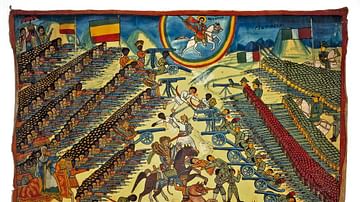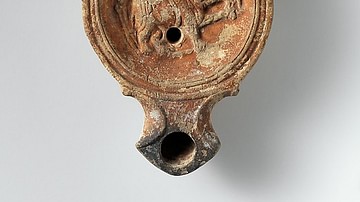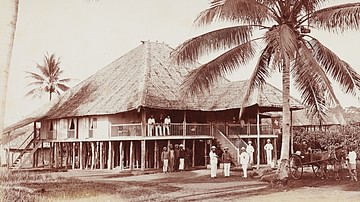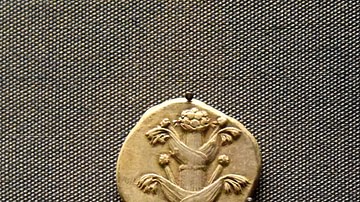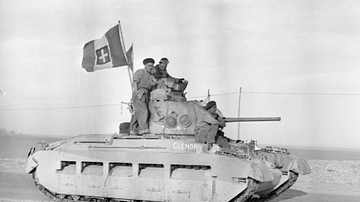One of the most coveted projects of Italian colonial policy was to secure an African colony in the Mediterranean. For this reason, Italy fought and won the Italo-Turkish war of 1911-1912 for the control of Tripolitania and Cyrenaica. These two possessions in Northern Africa were later unified in 1934 to form the colony of Libya, which remained under Italian control until 1943.
Tripolitania and Cyrenaica were characterised by continuous clashes between the Italians and Libyan resistance movements. The conflict lasted until 1932, when a ‘pacification’ campaign conducted during Benito Mussolini's (1883-1945) fascist rule violently repressed the rebellion.

The Diplomatic Preparation For Invasion
One of the long-term aims of Italy’s colonial plans was an expansion on the other shore of the Mediterranean. Italian appetites were first directed towards Tunisia, but in 1881 France imposed a protectorate there, frustrating Italian ambitions. The French move was perceived as a humiliation, hence it was often referred to as ‘the slap of Tunis’, and it diminished the possibilities of finding a suitable alternative for an Italian outpost in North Africa. Attention was, therefore, shifted towards Tripolitania, selected because it was one of the few places free from the control of other European powers and because it could constitute a strategically useful naval base in the Mediterranean. Tripolitania corresponds to the northern and coastal part of modern-day Libya but was then a semi-autonomous province (vilayet) of the Ottoman Empire (circa 1299 - 1922).
Ottoman suzerainty was more nominal than effective: between 1711 and 1835 the region was virtually independent under the rule of the local Karamanli dynasty. Even after the Ottomans had restored control in 1835, Tripolitania was under the influence of a political-religious fraternity called the Sanusiyya. This brotherhood was established in 1837 by Muhammad Ibn 'Ali Al-Senussi (1787-1859), an Algerian mystic who aimed to restore Islam to its early practice. Thanks to a successful integration within the Libyan tribal system, the Sanusiyya soon became an important centre of power, one that would later coordinate the resistance against the Italian invasion.
Returning to Italy, nationalistic press of the late-19th century emphasised the possibility of transforming Libya into a flourishing land for Italian emigrants, imagining the area as the future centre of trade across Africa. However, the Italian government was well aware that Libya had few natural resources - oil would only be discovered in 1955 - and a demographic colonisation would have been an arduous project. Moreover, at the time of the invasion, there were fewer than 1,000 Italians settled in Libya. Consequently, it was impossible to justify a war as a way to protect Italians abroad. As it was for Italian colonialism in Eritrea, the main justification was one of prestige and so Italy could sit at the table of the Great Power. The first military plans for an intervention in Libya came immediately after the ‘slap of Tunis’, then a tide of consequent events drove Italian action.
Nonetheless, it was fundamental to accompany the military preparation with diplomatic efforts to justify any Italian move on Libya. At the time, Italy was part of the Triple Alliance, together with the Austro-Hungarian Empire and the German Empire, who had been allies since 1879. This new military pact, another consequence of the ‘slap of Tunis’, was secured in 1882, and officially marked the end of a long period of friendship between the Kingdom of Italy and France. Even though the Italians received, in 1891, reassurances from their new allies regarding support for colonial claims, it was impossible to gain any progress in the Mediterranean without the consent of the true powers of the Mediterranean: France and Great Britain. Moreover, at the time Italy had to reassess its colonial policy after the defeat at Adwa in 1896 against the Ethiopian Empire, which blocked Italian expansionism in the Horn of Africa. The Mediterranean became, then, even more important for the Italian navy, due to the uncertainty of the situation in the Red Sea. France and Great Britain had already agreed on their respective areas of influence with the Anglo-French Convention of 1890. Therefore, Italy was forced to search for a rapprochement towards France and a series of diplomatic contacts culminated in the Italo-French agreement of 1901. This was followed by a similar Anglo-Italian agreement in 1902. This triangulation gave Italy a free hand in Tripolitania in exchange for Italian non-interference in any British interests in the Mediterranean and French claims in Morocco.
The international preparation was accompanied by a pervasive domestic policy. The topic of Libya was pushed by pro-colonialists and newspapers. The Banco di Roma, one of the main Italian banks, started to invest significantly in Tripolitania. To this must also be added the internal political calculations of the Prime Minister Giovanni Giolitti (1842-1928). One of the most important political leaders, Giolitti's tenure witnessed economic expansion and progressive social reforms, such as the introduction of universal male suffrage in 1912. In addition, he was politically unscrupulous and his trasformismo was noted, that is, the political art to create (too) flexible coalitions of government. Giolitti was also frequently associated with episodes of corruption. The war in Libya was one way to strengthen his government by seeking the support of the nationalists and the liberal conservatives.
Another important factor was the Ottoman Empire. In 1876, Abdul Hamid II (1842-1918) became sultan, paving the way for decades of absolutist rule. There was a broad opposition movement to the sultan, called the Young Turks, that was advocating for a constitution. Their revolution against the sultan in 1908 led to a period of restored parliamentary rule in the empire, but also brought internal instability and international weakness. In 1908, Bulgaria declared its independence from Ottoman rule, and the Austro-Hungarian Empire annexed Bosnia and Herzegovina, sharpening the tensions in the Balkans which became one of the major causes of WWI (1914-18).

Invasion: The Italo-Turkish War
The fragility of the Ottoman Empire was indeed one of the factors that encouraged Italian action. However, the final push came from the aggressive policy of Germany. The Kaiser William II (1859-1941) was promoting a Weltpolitik (‘world politics’), an imperialist foreign policy supported by a robust naval rearmament. In 1911 international tension reached a new level of stress when a German cruiser entered the port of the Moroccan city of Agadir, starting a crisis with France concerning Morocco. This situation could have jeopardised Italian diplomatic efforts, but it was also an opportunity for a targeted expedition in Libya. Giolitti, together with the Minister for Foreign Affairs Antonino di San Giuliano (1852-1914), sent an ultimatum to the Ottomans and then declared war one day later.
The first phase of the war in Libya started with the bombing of the coastal cities of Benghazi and Tripoli, where Italian troops landed on 3 October 1911. These first attacks by the Italian navy were followed by the air force, which was deployed for the first time in a war. However, the operations were proceeding too slowly for the Italian government, and Ottoman officials, together with the Libyans, began to launch the first forms of resistance. The situation was completely new for Italian troops: they were not facing a regular army but a form of organised guerrillas instead, who were able to launch an effective counteroffensive. The Italian government received international criticism for the situation. Other European powers feared that a prolonged clash would have destabilizing effects beyond Libya. The government also had to face lively internal opposition, despite the backing for the war in nationalist circles and from some intellectuals. The poet Giovanni Pascoli (1855-1912), for instance, in a famous speech supporting the war (La grande proletaria si è mossa) linked the socialist refrain of improving the living conditions of the Italian proletariat with the nationalist idea of the redemption of national pride. The Italian Socialist Party, although divided on the issue, opposed the conquest of what was defined as "a big sandbox" (Salvemini) due to the dubious economic benefits of the war. Even Benito Mussolini, later founder of Fascism and dictator of Italy, was at the time a fervent anti-interventionist socialist.
The government forged ahead with the formal annexation of Cyrenaica and Tripolitania on 5 November, but Libya was far from being actually under Italian control. After this first phase of impasse, Italian troops proceeded inland. Notwithstanding a series of battles won, the government pushed military actions against Turkey both in the Red Sea and in the Mediterranean, with the occupation of a few islands to show the purposefulness of Italy’s war plans. The fragility of the Ottoman Empire was the key to the Italian military progress in Libya. The Ottomans were facing a more serious turmoil in the Balkans, and were forced to deploy more troops there, where the first Balkan war (1912-1913) soon broke out. Furthermore, Italy had occupied the Aegean islands of the Dodecanese to put further pressure on the Ottomans. For Constantinople, it was impossible to resist on both fronts, and after diplomatic talks with Italy started in July, a peace treaty was signed in Ouchy on 18 October 1912.

The Policy of the Statutes
Effective Italian control at the end of the conflict was only achieved along the coast, and the outbreak of the First World War in 1914 made capitalisation of the conquest impossible. The war had also jeopardised Giolitti’s government, where all the opposition parties radicalised towards anticolonial stances. The peace treaty did not have an effect on Libyan society: there were proclamations of resistance and the treaty left Constantinople the authority to nominate a ‘caliph’ in Libya, a sign that the Turkish presence was still not completely erased. In the meantime, the occupation was proceeding with difficulty through 1913 and 1914 in the regions of Fezzan and Cyrenaica. The Italian participation in WWI from 1915 further weakened any military progress, and many conquered places were retaken by the Libyan resistance so that Italy was forced to withdraw towards the position obtained in 1912, solely controlling the coast. The withdrawal did not shock Italian public opinion as it had during the Italian colonisation of Eritrea; Italians were (pre)occupied by the news of the Great War. The government, as well as the British Empire that was fighting the Sanusiyya in Egypt, was then forced to compromise in Cyrenaica with the still influential Sanusiyya. With the agreement of Akrama of 1917, the leader of the fraternity Muhammad Idris (1889-1983) gave up the revolt and ended any collaboration with the Ottomans, but he did obtain the right to maintain armed troops.
If the situation in Cyrenaica was stabilised, in Tripolitania hostilities were still open. The government opted for an agreement with the self-proclaimed Tripolitanian Republic that had been leading the resistance since 1918. Following the agreement with the resistance of Khallet ez-Zeitun (1919), the people of Tripolitania were granted a Fundamental Pact, known as the Libyan Statute. Tripolitanians were no longer subjects of Italy but obtained the ‘Italian citizenship of Tripolitania’, a status that, even if different from the standard Italian citizenship, granted the right to petition the parliament in Rome and to create a local parliament that could impose tributes. The statute also granted liberty of the press and association, promotion of the Arabic language, and the abolition of mandatory military service. The ‘policy of the Statutes’, promoted by the post-war liberal government of Vittorio Emanuele Orlando (1860-1952) and Francesco Saverio Nitti (1868-1953), was extended to Cyrenaica, where the modus vivendi of Akrama was replaced by the pact of ar-Rajma in 1920. Cyrenaicans obtained a parliament as well, and the Sanusiyya maintained both military control, thanks to the right to maintain troops, and religious leadership, under the authority of Idris with the title of Emir of Cyrenaica.
The Fascist 'Pacification' of Libya (1923-1932)
The system of the Statutes entered a crisis when Mohammed Idris was offered the title of Emir over Tripolitania. The leaders of the resistance in Tripolitania were not satisfied with the results of their agreement and decided to re-establish the Tripolitanian Republic and to resume the hostilities. However, they soon fell into internal divisions and so hoped to find in Idris a leader that could guide the revolt. Mohammed Idris effectively accepted the title on 2 November 1922. This act was seen by Rome as possibly compacting the resistance. The change in the national government, with a hardliner colonialist Giuseppe Girardini (1856-1923) as Minister for Colonies and Giuseppe Volpi (1877-1947) as governor in Tripolitania, saw a push towards the end of the policy of Statutes. The truce with the Libyans was not reconfirmed, and in 1921 hostilities resumed. After the first attack struck by the resistance, Volpi launched the reconquest of those areas of Tripolitania controlled before 1915 and beyond.

The advent of Fascism in 1922, when Mussolini took power in Rome and started to transform Italy into a dictatorship, decreed the end of any further possibility of compromise or pact with the Libyans. Mussolini encouraged the military operations led by Volpi which, in 1923-1924, initially weakened the resistance. In fact, ultimately a new and reinvigorated resistance was formed under Umar al-Mukhtar (1858-1931), an Imam who became the leader of the Libyan resistance movement. The situation led to the second Italo-Senussi war, or, as it was called by the Italians, the ‘pacification’ of Libya. Under Fascism colonies would receive renewed attention, and Libya was no exception, as demonstrated by a series of high-profile state visits, such as by King Victor Emmanuel III (1869-1947) in Tripolitania in 1928 and by Mussolini in 1926 in Tripoli. A new aggressive tone of Italian foreign policy demanded a stronger reaction in Libya. The new aim was the conquest of the south of Tripolitania and the reconquest of Cyrenaica. The military progress in Cyrenaica, however, was slower than in Tripolitania. Mussolini then decided to deploy general Pietro Badoglio (1871-1956), who intensified military operations in Tripolitania, with the aim of conquering the Fezzan, and starting negotiations in Cyrenaica, ultimately obtaining a truce with Umar al-Mukhtar in 1929.
The truce did not last long, and Mussolini appointed the unscrupulous general Rodolfo Graziani (1882-1955) as vice governor. Graziani, remembered as the 'butcher of Fezzan', was responsible for the escalation of violence that characterised this second phase of the war. The general ordered the expropriation of the property of Libyans and the forced grouping of those populations living in the Jebel Akhdar area, usually semi-nomadic, towards the coast, interning them in concentration camps, and that after long death marches in the desert. The fighting intensified and the air force even used mustard gas; a chemical weapon formally banned in 1925. The people of Cyrenaica were forced to adapt to a new way of life in harsh conditions, with the result that the total population of Cyrenaica decreased by more than a quarter (Mann, 309), counting both deaths and the number of people who were exiled or managed to flee. Eventually isolated, the leader of the resistance Umar al-Mukhtar was found, arrested, and hanged in 1931. With the death of its leader, the resistance collapsed and soon the entirety of Libya was ‘pacified’. The concentration camps started to be dismantled in 1932, but many people were not brought back to their places of origin but displaced to new and unfamiliar locations
From the '17th Italian Region' to Independence
A new phase was opened when Italo Balbo (1896-1940) became governor of a unified Libya in 1934. Balbo was, in reality, ‘exiled’ over fear that his popularity in Italy could threaten Mussolini’s own grip on power. Balbo pushed to integrate Tripolitania and Cyrenaica as part of Italy in 1939, as the 17th Italian region. He tried to integrate Libyans, with the construction of new villages with mosques and with massive infrastructure works, such as the ‘via Balbia’, a highway along the Libyan coast. The governor tried to give full Italian citizenship to Libyans, as he considered them 'Italian Muslims of the fourth shore of Italy', but Mussolini refused. Balbo also pushed for the ‘colonisation of the twenty thousand’, a mass transfer of Italian farmers to Libya in 1938. However, the governor’s project for Libya came to an unexpected end when the airplane he was piloting was shot down by Italian anti-aircraft friendly fire on 28 June 1940.
The Second World War (1939-1945) arrived in Libya during a period of major demographic colonisation. While Italian East Africa collapsed in 1941, Libya became the theatre of the North African campaign (1940-1943), where German and Italian troops fought the British for control of Libya and Egypt. After the victory of the Allies, Libya first came under the military control of France and Great Britain, then gained independence in 1951 as a kingdom under the chief of the Sanusiyya, Idris. Relations between Italy and Libya, especially after the revolution led by Muammar Gheddafi (1942-2011) in 1969, were characterised by discussions on compensation for the damage suffered during the period of Italian colonialism. In 1970, Gheddafi seized all the properties of those Italians who remained in Libya after the war, forcing them to leave the country. Only in 2008 did Libya and Italy reach an agreement regarding compensation.




